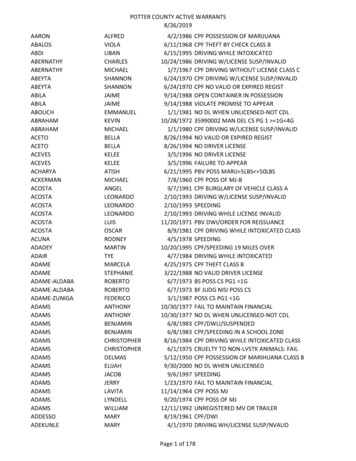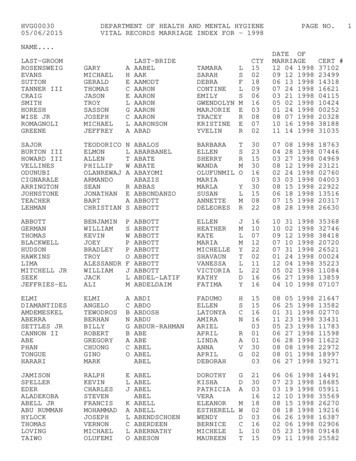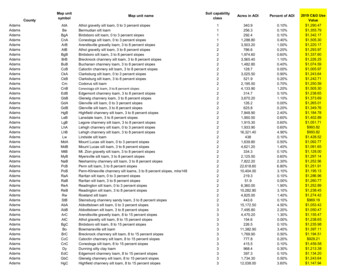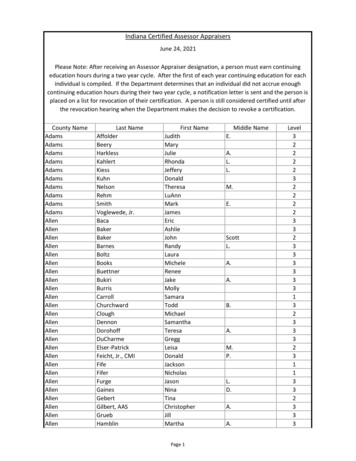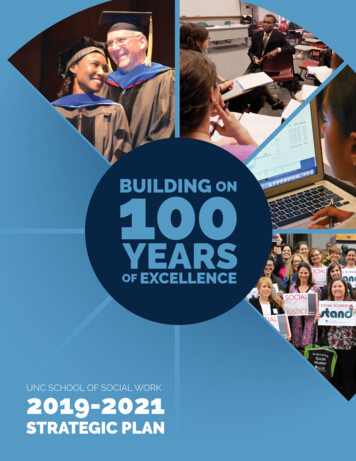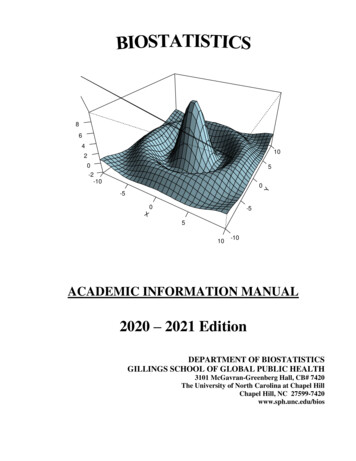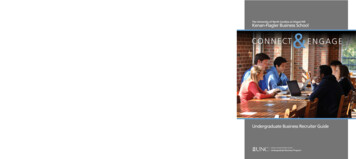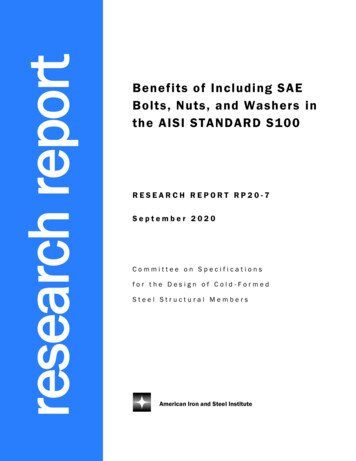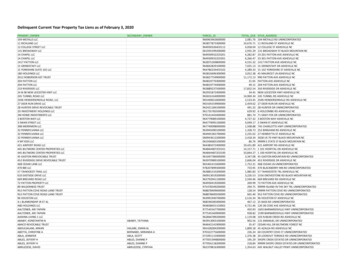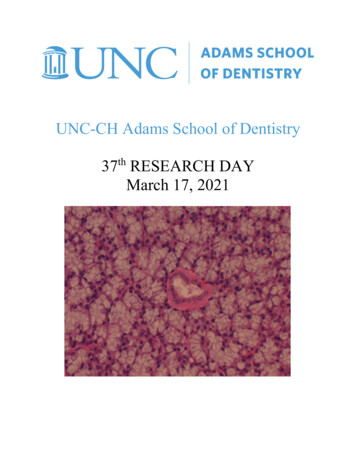
Transcription
UNC-CH Adams School of Dentistry37th RESEARCH DAYMarch 17, 2021
TABLE OF CONTENTSWelcome letters . 3Research Day Keynote Presentation . 5SCHEDULE OF EVENTS . 7ORAL PRESENTATIONS . 7PRESENTATION SCHEDULE . 10ABSTRACTS . 14ACKNOWLEDGEMENTS . 52SPONSORS . 53Cover image taken by:Adele Musicant, postdoctoral researcher, AdamsSchool of Dentistry, University of North Carolina atChapel HillResearch mentor: Antonio Amelio“Heart-shaped salivary gland duct”.I
WELCOME LETTERSDear Colleagues,We would like to welcome everyone to the 37th Annual Dental Research Day. This year we willhave a hybrid meeting, with both virtual and selected in-person events. At the Adams School ofDentistry, we are committed to inspiring, creating and supporting all aspects of Discovery andInnovation. This is highlighted by the diverse, inspiring and high-quality accomplishments of ourstudents, faculty, staff, research fellows and visiting scholars being shared at the Annual DentalResearch Day.It is clear from the array of work to be presented, that investigators within the School interact andcollaborate with investigators on the UNC-CH campus, as well as with leading investigators andinstitutions elsewhere in the United States and abroad. Indeed, we are very excited to have 56-oraland poster presentations and keynote address by Dr. Rena D’Souza, DDS, MS, PhD, Director ofthe National Institute for Dental and Craniofacial Research, National Institutes of Health. She is aclinician-scientist that has been strongly committed to discovery and mentoring throughout heracademic career.In addition, there will be 5 virtual seminars and 2 in-person hands-on workshops. This year, theResearch Day Executive Committee created the new Steven Offenbacher Excellence in Dental andCraniofacial Research Award. This research award offered by the ASOD recognizes Dr.Offenbacher’s contributions to the field of dental and craniofacial research.It is our hope that you enjoy the day’s activities designed to promote the fellowship of Discoveryand Innovation and crafted by the organizing committee which includes the North Carolina Sectionof the American Association of Dental Research and the local chapter of the Student ResearchGroup.We are excited to share in the day’s experiences with each of you,Shannon Wallet, PhD, AssociateDean for Discovery and InnovationJulie Byerley, MD, MPH, interim Dean of theAdams School of Dentistry
Dear Colleagues,We are thrilled to welcome you to the UNC-Chapel Hill, Adams School of Dentistry 37th AnnualResearch Day. This year is especially exciting because it is the first time the event will be hostedin a hybrid format with virtual sessions and select in-person events. It is a day of celebration whichenables students, trainees of all levels, faculty, staff, visiting scholars, alumni, and exhibitors toengage with one another and present their research accomplishments towards which they haveworked so hard.The North Carolina Section of the American Association for Dental Research (NCAADR) and thelocal chapter of the Student Research Group are excited to see how this historic event continues togrow every year and are eager to experience the opportunities provided by a hybrid format.Despite the setbacks and challenges everyone has faced due to COVID-19, we have 56 poster andoral presenters: 16 dental students, 25 masters and PhD students, 9 post-doctoral fellows andvisiting scholars, 2 undergraduate students, 3 staff members, and 1 faculty member. The researchpresented covers a variety of fields including Biomaterials/Dental Materials, Craniofacial andSkeletal Biology, Cancer Biology, Education Research, Imaging/Therapeutic Modalities,Population and Epidemiology, Social Science, and Tissue Repair/Regeneration/Wound Healing.We are honored to welcome Dr. Rena D’Souza, D.D.S., M.S., Ph.D., who is currently serving asthe director of NIH’s National Institute of Dental and Craniofacial Research (NIDCR), as ourkeynote speaker. Her presentation on “How Science and Technology Advances will Shape theFuture of Oral Health Research” supports our school’s mission of becoming the global model fororal health education, in care and discovery. We would also like to thank all of our seminar andworkshop leaders, presenters, attendees, and event sponsors for supporting our researchers andhelping make this a day full of scientific exchange and collaboration.We hope you all have a great day as you explore the achievements of our researchers and we lookforward to another successful scientific event!Julie MarchesanMustafa Girnary, Second year DDS studentPresident Student Research GroupJulie Marchesan, DDS, PhD. AssistantProfessor, President NC-AADR
RESEARCH DAY KEYNOTE PRESENTATION12-1PM, Wednesday March 17, 2021Virtual presentationPlease visit https://dentistry.unc.edu/discovery/research-day/ (underevent registration)Dr. Rena N. D’SouzaHow Science and Technology Advances will Shape the Future ofOral Health ResearchRena N. D’Souza, DDS, MS, PhDDirector, National Institute of Dental and Craniofacial ResearchIn this presentation, Dr. D’Souza will talk about the recent increase in knowledge of the geneticand molecular control of craniofacial and palatal morphogenesis. However, the interactionsbetween signaling pathways that regulate the growth and fusion of palatal shelves are largelyunknown. Since it is the interaction between molecules rather than the intrinsic functions of anyindividual gene product that is responsible for the orchestration of pattern formation, this is animportant problem that is critical to resolve. For the first time, we show that the Wnt gene signalingpathway is important in palatogenesis. Our data also illustrate the importance of the role ofectodysplasin (Eda/r) signaling in the Pax9-mediated tooth agenesis and cleft palate formation wefurther delineate the roles of signaling pathways. Controlled in-utero delivery of small moleculeWnt and Eda agonist therapy consistently induces palatal shelf closure in Pax9 mutant mouseembryos. Collectively, these studies advance our understanding of how key signaling pathwaysinteract during normal and abnormal palate formation. Such basic science knowledge will providea strong biologic rationale for the development of safe therapies that can prevent or correct cleftdefects in humans.In the concluding segment of the talk, information will be shared on The National Institute ofDental and Craniofacial Research (NIDCR) which is the U.S. federal government’s lead agencyfor scientific research on dental, oral, and craniofacial health and disease. NIDCR funds a dynamicportfolio of dental, oral, and craniofacial research spanning basic, translational, social andbehavioral, and clinical research domains, and supports a strong research workforce throughresearch training and career development awards.
Dr. D’Souza is the Director of the National Institute of Dental and Craniofacial Research, NationalInstitutes of Health. She is deeply committed to the organization’s mission — to improve dental,oral and craniofacial health — and believes the institute plays a key role in how oral health care isdelivered.Prior to becoming NIDCR’s director, Dr. D’Souza served in the position of Associate Vice Provostfor Research for the University of Utah and as Assistant Vice President for Academic Affairs andEducation for the Health Sciences. She held the Ole and Marty Jensen endowed chair in the Schoolof Dentistry where she served as inaugural dean. As a clinician-scientist, D’Souza has beenstrongly committed to discovery and mentoring throughout her academic career. She is a pastpresident of the American Association for Dental Research (AADR) and the InternationalAssociation for Dental Research (IADR).She has authored over 150 publications and book chapters in the areas of craniofacial development,matrix biology and tissue regeneration for over 30 years. She is a Fellow of AAAS and also ofAADR. Dr. D’Souza received the Presidential Award for Research Excellence from the TexasA&M Health Science Center in 2010 and was inducted into the German National Academy ofSciences in 2012. She was recognized as the Columbia University College of Dental Medicine’sBirnberg Research Medal in 2016 and received the Irwin D. Mandel Distinguished NationalMentoring Award in 2017.Dr. D’Souza will maintain an active research laboratory in the National Institute of Child Healthand Human Development (NICHD), NIH.
SCHEDULE OF EVENTSMarch 17, 2021 (Wednesday)TimeActivity7:30-8:30amLogin set-up and vendor m-11:45pm12-1pm2:30-4:30pmExhibition openWelcome and opening remarksJulie Byerley, MD, MPH. Interim Dean, UNC Adams School of DentistryJulie Marchesan, DDS, PhD. President NC-AADRVirtual Oral presentations (with award competitions*)Virtual poster presentations (with award competitions*)Keynote Presentation (virtual presentation)“How science and technology advances will shape the future of oral healthresearch” presented by Dr. Rena D’Souza- Seminars and Workshops (by registration only)- Vendor exhibition (ASOD atrium and virtual)March 19, 2021 (Friday) – SAVE THE DATE!TimeActivity12-1pmAward ceremony at the Adams School of Dentistry (in person, by registrationonly – Koury G405).ORAL PRESENTATIONSTo access the virtual presentations, please visit under event registration).SEMINARSSeminar 1: How to conduct high quality clinical research at the ASODPresenterShannon Wallet, PhDLearning objectives:1) To increase your general knowledge about the logistics of conducting clinical research2) To learn about the different types of clinical research and trials3) To understand the opportunities for developing research at the UNC GoHealth Clinical Center4) Learn about the types of services that the clinical center can offer to conduct a clinical projectof the highest quality possible
Seminar 2: Oral Cavity at the COVID-19 Crossroads: Infection, Transmission, and PreventionPresentersJennifer Webster-Cyriaque DDS PhDProfessor, Division of Craniofacial and Surgical Care, ASOD-UNCProfessor, Division of Oral and Craniofacial Sciences, ASOD-UNC Professor, Department ofMicrobiology and Immunology, School of Medicine-UNCDirector, Viral Oral Infections in Immunosuppression and Cancer (VOIICe)PI and Director, Mechanisms of Translation Realizing Discovery and Understanding the PipelineCTSA Post-Doctoral Program, UNCKevin Byrd, DDS, PhDResearch Assistant Professor in the Division of Oral & Craniofacial Health Sciences.Learning objectives:1) To understand the known viral epidemiology of the current pandemic2) To understand the systemic and oral pathogenesis and transmission dynamics of SARS CoV23) To understand the diversity of human oral cell types that comprise the two distinct niches inadults4) To discover how oral cell subpopulations are at-risk for infection broadly by viruses such asSARS-CoV-25) To learn how infection of the oral tissues sets up a silent transmission axis in COVID-19.Seminar 3: How to effectively manage your research programPresenterSusan Pusek, DRScDirector, Education Programs, NC TraCS Institute, University of North Carolina at Chapel HillLearning objectives:a) Understand the importance of project management for successb) Apply skills of project management to managing one's researchprojectc) Run effective meetingsd) Anatomy of NIH RFASeminar 4: Presentation and Discussion of Oral and Maxillofacial Pathology CasesPresenterRicardo Padilla, DDSBoard Certified Oral and Maxillofacial Pathologist, Residency Director – UNC Oral andMaxillofacial PathologyKaneda Distinguished Associate Professor of Oral and Maxillofacial PathologyDivision of Diagnostic Sciences, Adams School of Dentistry, University of North Carolina atChapel Hill
Learning objectives:1) To understand the clinical, radiographic, microscopic, and laboratory findings of common anduncommon cases of oral and maxillofacial pathologic conditions2) To learn how to progress through the diagnostic process and management of each of the casespresented.Seminar 5: The future of radiology in dentistry: where are we now and where are we going?Presenter:Donald A Tyndall DDS, MSPH, PhD, FICDDiplomate ABOMRProfessor, Department of Diagnostic SciencesLearning objectives:1) To increase your knowledge of future trends in dental radiology2) Increase understanding of how they will be applied in the practice of dentistryWORKSHOPSIn person workshops have a limit capacity of 20-30 participants – by registration onlyWorkshop 1: The Use of Soft Tissue Substitutes for Ridge Preservation and Root CoverageProceduresPresenterThiago Morelli, DDS, MSDivision of Comprehensive Oral Health, Periodontology, Adams School of Dentistry,University of North Carolina at Chapel HillRoom number: ASOD Koury, 1405 and 1411 (SimLab)Learning objectives:a) Understand how to select cases that require soft tissue augmentationb) Learn about the techniques and materials currently available - the scientific evidence tosupport itc) Hands-on experience practicing soft tissue graftingWorkshop 2: Guided surgery: now and the futurePresentersMatthew Mason, DDS, MS, PhDAssistant Professor - PeriodontologyUNC Adams School of Dentistry
Room number: ASOD Koury, G508Marta Musskopf, DDS, MSD, PhDPostdoctoral Research Associate - PeriodontologyDivision of Comprehensive Oral HealthUNC Adams School of DentistryRenata Camino Navarro, DDS, MSAssistant Professor - ProsthodonticsDivision of Comprehensive Oral HealthUNC Adams School of DentistryLearning objectives:a) Learn about dynamics guiding of implant placementb) Understand how to introduce novel technologies into your treatment planc) Understand the differences between static and dynamic guided surgeryPRESENTATION SCHEDULETo access the virtual presentations, please visit under event registration).Oral Sessions(8:45-10am)CraniofacialSkeletal DiseasesTimeand nand 8:45-9amBiomaterials & DentalMaterials9-9:15amPresenterTitleThomas BraderImproved Quality of Life in PostcondylectomyPatients:ARetrospective AnalysisMary Morgan Orthognathic Speech Pathology:Bitler KeyserImpacts of Anterior Open Bite onSpeechMarta Musskopf Minipig Intraoral Dental atterns of Fillings, Crowns, andSimancarlasExtractions in the Primary DentitionPallaresAmanda Finger Evaluation of a Novel AlloplasticStadlerBiomaterialMylan YoungLow-Intensity Pulsed Ultrasound(LIPUS) Effect on Murine SkeletalMuscle Regeneration
9:15am9:30am9:30-9:45amSocial SciencePopulationEpidemiologyand herapeuticsPatient Careand tthew PhamAccuracy of Patient Specific PlatesDuring Lefort I OsteotomyAnastassiaTooth Autotransplantation: CurrentDokovaPractices, Barriers to Adoption andFuture DirectionsKatelyn CassPatient and Caregivers Perceptionson Animal Assisted Therapy inOrthodontics.Daniel LeeIdentifying factors that yNC Medicaid: Participation andGoldsmithperceptions among orthodontists. A15-year update.James ZhongTraumatic Dental Injury RiskAppraisals by Orthodontists andPediatric DentistsJoshua RaisinBarriers to oral health care fortransgenderandnon-binarypopulationsKshitij Parag- ugTolerance in Salivary-Gland CancerWilliamLateral Flow Assays Detect SarsSeamanCoV-2 N-antigen/anti-Sars-CoV-2IgG/IgM in Patient SalivaLieslJeffers- Metal Nanoparticle As A ShieldFrancesAgainst imposition in Rapid PalatalExpansion CasesBrittanieCreating a Medical-Dental ReferralAlmitra Height Pipeline for Patients with Diabetes.andMoniqueDuruPoster sessions(10:15-11:45am)Poster Session 1(10:15-10:45am)Craniofacial andSkeletal MustafaGirnaryVinicius dePaivaGonçalvesCaspase-1-mediated PeriodontalBone Destruction is Sex-dependentSystemic Dietary Hesperidin AffectsOsteoclastogenesis and Ligatureinduced Alveolar Bone Loss
Biomaterials/DentalMaterials andRegenerationPoster Session 2(10:45-11:20)Population 35amAli Altitinchi10:3510:40am10:4010:45amAnna Farrell10:1510:20amZaid Badr10:2010:25amTariq Alsahafi10:2510:30amAli Altak10:3010:35amCoco Roening10:3510:40amLauren KatzDifferential Mechanisms ofCraniofacial Myogenesis OfferInsight into Regenerative Therapies10:4510:50amZachary Burk10:5010:55am10:55-11amMeredith Davis11-11:05amAmrita Temble11:0511:10amEmily Imes11:1011:15amPoojan ShresthaClinical Patterns of PrimaryDentition Developmental Defects ofthe EnamelAdiposity and Oral Health in NorthCarolina Preschool-age ChildrenDental Utilization Differences inOlder Adult U.S. Birth CohortsSociodemographic Factors andOlder Adults’ Self-Rated OralHealth Status, 2008-2018Guardian-Reported Child OralHealth Correlates with UntreatedDisease and ToothachesLower Caries Experience AmongChildren with Dental HomesClare BlocklageAnna BatorskyExtended Antibiotics AfterOrthognathic Surgery Do Not LowerInfection RatesThe therapeutic role of CDDO-Mein modulating Nrf2 to control TLRinduced inflammation in human oralkeratinocytes.Dysbiosis During ExperimentalPeriodontitis DevelopmentOrthodontic Loading Activates CellSpecific Autophagy In A ForceDependent MannerStrength and Survivability ofZirconia Crowns as a Function ofYttria Concentration.In-vitro wear of bulk-fill resincomposites after thermo-mechanicalloadingLight-cure Irradiance, Energy andTip Distance Through Resin-basedCADCAM MaterialsGeographical variations inmicrobiota from immature teethwith necrotic pulp
Social Sciences/ClinicalStudies11:1511:20amBreanne SmithExamining Caregiver Oral HealthLiteracy and Children Oral HealthStatus10:4510:50amHannah Archer10:5010:55amGabriella Gallo& Deborah Liu10:55-11amAmandaSwanson11-11:05amJason ne MeierOral Health Content Lacking onNon-Dental Safety Net ClinicWebsitesIdentifying COVID-19's Impact onDentists’ Workforce Confidence andWorkflow Changes“No Wrong Door” to HypertensionControl: Interprofessional ServiceLearning in DentistryA SEER Database Analysis ofAdenoid Cystic Carcinoma PatientSurvivalHybrid Pain Management StrategyLimits Left-over Opioid DosesPseudoaneurysms After Lefort IOsteotomyActively Growing UnilateralCondylar Hyperplasia in aHeterogenous Population11:1511:20am11:2011:25amKamaira Philips11:2511:30amWai-SumLeung11:3011:35amHannah Cheung11:3511:40am11:4011:45am11:45am11:50amTaylor SchmidtKevin ChanElisa HannahPoster Session emannSarah MorganExploring A Career In AcademicDentistryEvaluating Student PreparednessTowards Providing Oral HealthcareFor Hemophilia PatientsImplementing EnvironmentalSustainability EducationalIntervention in Dental HygieneInstructionDental Hygiene Curricula: TreatingPatients with Intellectual andDevelopmental DisabilitiesPoverty Simulation and ExtramuralRotations: Connecting the Dots?Web-based unfolding case study inan interprofessional online classLearners as Leaders: QualityImprovement Methodology in PreDoctoral Dental Education
11:5011:55amEllen StewartPreclinical virtual removable partialdenture survey and design11:1511:20am11:2011:25amRyan Murphy11:2511:30amColin onSpangler11:4011:45amSamanthaJhingreeSYNGR3 Expression has DiagnosticValue in HPV16-associated HNSCCMicro-CT as Reference Standard forEarly Carious Lesion ActivityAssessmentDoses Associated With VariableCollimator Distances DuringBitewing ExaminationsGeographic Tongue as a ReactionDiffusion SystemSculptorHD: A Web-BasedRendering Application forCommunicating Dental ConditionsValidation of Spectral MomentAnalysis to Characterize SpeechDistortion SeverityBioinformatics/Imagingand TherapeuticModalitiesAdam HoxieABSTRACTSORAL PRESENTATIONSCraniofacial and Skeletal Diseases1) Improved Quality of Living Following Combined Condylectomy and OrthognathicSurgery: A Retrospective Analysis for Active Unilateral Condylar HyperplasiaBrader T1, Bhatt P1, Turvey TA11Department of Oral and Maxillofacial Surgery, School of Dentistry, University of North Carolinaat Chapel HillObjectives: To assess quality of life in patients who underwent combined condylectomy andorthognathic surgery in conjuration with orthodontic treatment for active unilateral condylar (TMJ)hyperplasia. This pathologic process can lead to the development of esthetic and functionalconcerns. High condylectomy (7-10mm of bone removed from condylar process) is the treatmentstudied, but currently, there is no published literature that analyzes patient satisfaction. Methods:61 patients who underwent simultaneous condylectomy and orthognathic surgery for activeunilateral condylar hyperplasia at UNC hospitals between 2004-2017 (minimum 4 years postop)were mailed a questionnaire containing 21 questions to assess their quality of life after undergoinghigh treatment. All patients underwent orthodontic treatment. Results: 25 (41%) patientscompleted the questionnaire. 17 (68%) were female and 8 (32%) were male. 24 (96%) reportedthat that they are satisfied with their results. Even after fully realizing everything involved withtreatment, these 24 respondents endorsed that they would do it again. Benefits of treatmentincluded appearance change, improved mastication, reduction of discomfort and improvement of
jaw functioning etc. Indication for treatment differed for each patient but when polled on theirgreatest benefit derived from treatment, 13 (52%) reported appearance change, 19 (76%) reportedimproved mastication and 7 (28%) reported reduction of discomfort (ten respondents providedmore than one “greatest benefit”). Overall, 9 (36%) patients endorsed TMJ pain prior to surgeryand 6 (66%) of those individuals reported that they no longer suffer from TMJ arthralgia of anymagnitude. Furthermore, 10 (40%) patients reported “clicking” prior to treatment, with 13 (52%)reporting “clicking” afterwards. Of the 25 surveyed patients, 9 (36%) reported frequent headachesprior to treatment. 100% of these individuals reported a decrease in frequency and intensity ofheadaches since treatment. Based on the preoperative clinical findings of the 25 patients, 13 (52%)patients were classified as Type I (Hemimandibular Elongation), 4 (20%) were Type II(Hemimandibular Hyperplasia) and 8 (32%) were Type III (combination of type I and type II),according to the Obwegeser and Makek classification of condylar hyperplasia. Conclusion:Overall, a significant majority of patients undergoing simultaneous condylectomy andorthognathic surgery combined with orthodontics benefited from treatment. This is important forhealthcare providers when considering referral for condylar hyperplasia. Prior to this data,treatment was agreed upon between provider and patient based on the practical idea that surgicalintervention will improve quality of life. Now, potential patients can be educated on tangibletreatment outcomes when determining whether or not to pursue treatment, regardless of theirpresenting concern.2) Orthognathic Speech Pathology: Impacts of Anterior Open Bite on SpeechKeyser MMB1, Zajac D1, Bocklage C1, Oliver S1, Mielke J2, Jacox L1.1Division of Craniofacial and Surgical Sciences, Orthodontics, Adams School of Dentistry, UNCCH, 2Department of English, Linguistics Program, North Carolina State University Raleigh, NCObjectives: Speech-sound disorders (SSDs) are seen in 80% of dentofacial deformity (DFD)subjects compared with 5% of the general population, impacting communication and quality oflife, but the causal link is unknown. We hypothesize there are both qualitative and quantitativedifferences in spectral properties of stop (/t/ or /k/), fricative (/s/ or /ʃ/), and affricate (/tʃ/)consonant sounds and that severity of anterior open bite (AOB) jaw disharmony correlates withdegree of speech abnormality. Methods: To test our hypotheses, orthodontic records and audiorecordings were collected from DFD patients (n 39 AOB, 62 controls). A speech pathologistevaluated subjects and recordings were analyzed using spectral moment analysis (SMA) tomeasure sound frequency distortions. Results: A significant (p 0.01) increase in the centroidfrequency (M1) was seen in the /k/, /t/, and /tʃ/ phonemes of “all AOB” subjects compared to thecontrols. Stratifying the AOB sample by anterior-posterior, M1 differences were noted foradditional phonemes in Class II and III subgroups, indicating possible interaction between thevertical and anterior-posterior (AP) dimensions. Using linear regression, correlations betweenAOB skeletal severity (assessed via cephalometric measurements) and articulation distortion werefound for /k/ and /t/ phonemes. Conclusions: A higher prevalence of qualitative SSDs andsignificant quantitative spectral distortions in consonant phonemes were seen in AOB patientscompared to controls. Additionally, severity of skeletal AOB is correlated with the degree of SSDfor consonant phonemes. These findings provide insight into the interplay between craniofacialand vocal structures, and elucidate how the treatment of DFD may impact speech-sound disorders.3) Minipig Intraoral Dental Implant Model - Meta-Analysis on OsseointegrationMusskopf ML1, Finger Stadler A1, Wikesjö UM1, Susin C1.
1Laboratory for Applied Periodontal & Craniofacial Research Division of Comprehensive Oral Health,Periodontology, Adams School of Dentistry, University of North Carolina at Chapel HillObjectives: Minipig models are increasingly used to evaluate dental implant technologies,however, no systematic evaluation of their utility has been reported to date. The aim of this metaanalysis was to estimate osseointegration patterns in the Minipig Intraoral Dental Implant Modeland explore factors that may affect osseointegration. Methods: A systematic review includingPubMed and EMBASE databases through 2020 was conducted. Two independent examinersscreened titles/abstracts and selected full-text articles (published in English, Spanish orPortuguese) reviewed by one examiner for eligibility. Studies were included when titaniumimplants had been placed into native alveolar bone, and mean SD was reported or could beestimated. Assessment of risk for bias was performed to ascertain treatment allocation, examinermasking, and calibration. Random-effects meta-analyses and meta-regressions were done usingbone-implant contact (BIC) as the main outcome. Results: The search yielded 249 titles of which198 abstracts and 124 full-text articles were reviewed. 47 original studies qualified for thequantitative analysis. Randomization, masking, and calibration were reported in 51% (n 24), 25%(n 12) and 8% (n 4) of studies, respectively. Overall, BIC mean was 61.6% (95%CI: 59%64.28%). BIC increased significantly over time (p 0.001): 43.6% (95%CI: 36.2-51) at 2 weeks,58.4% (95%CI: 53.9-63) at 4 weeks, and 68% (95%CI: 65.1-71) after 4 weeks. Immediate implantsexhibited significantly lower BIC than implants that were placed into healed ridges (coef:20.18 4.5, p 0.0001). Non-loaded implants featured significantly lower BIC than loaded implants(coef: 10.1 4.7, p 0.03). No significant differences were observed for animal characteristics(strain or age), post-extraction healing time, and arch. Conclusions: The Minipig Intraoral DentalImplant Model appears to demonstrate osseointegration patterns similar to that observed inhumans. This conclusion should be interpreted with caution however due to the limited number ofstudies evaluating osseointegration histologically in humans. Funding Source: Nobel Biocare4) Patterns of Fillings, Crowns, and Extractions in the Primary DentitionSimancas-Pallares M1, Spangler H1, Ginnis J1, Vann Jr WF1, Wright T1, Ribeiro A2, Divaris K1.1Division of Pediatric and Public Health, Adams School of Dentistry, UNC-CH;, 2Division ofDiagnostic Sciences, Adams School of Dentistry, UNC-CH.Objective: Early childhood caries (ECC) is a broad disease definition that includes restored andunrestored disease as well as varying levels of severity. Caries lesions are distributed according toclinically recognizable patterns (e.g., smooth surfaces versus pits and fissures) but little is knownabout patterns of restorative and surgical ECC management (i.e. fillings, crowns and extractions).In this investigation our aim was to identify patterns of fillings, crowns, and extractions in a largesample of preschool-age children. Methods: We relied upon clinical surface and tooth-levelinformation on restorations and extractions from a community-based sample of children ages 3-5[N 6,404 of which 30% (n 1,940) from an epidemiologic study of early childhood oral health inNorth Carolina who had at least one restoration or extraction due to caries. To identify patterns(i.e., latent classes) of fillings, crowns and extractions in the primary dentition, teeth and
for scientific research on dental, oral, and craniofacial health and disease. NIDCR funds a dynamic portfolio of dental, oral, and craniofacial research spanning basic, translational, social and behavioral, and clinical research domains, and supports a strong research workforce through research training and career development awards.
